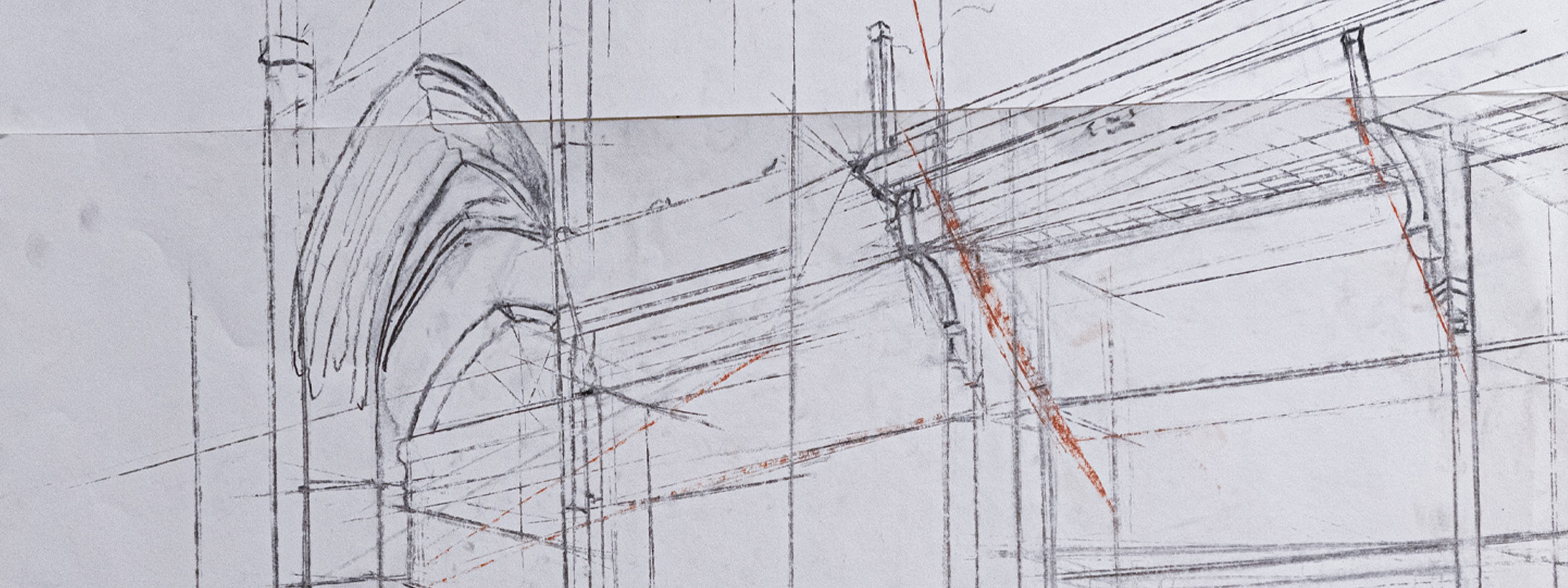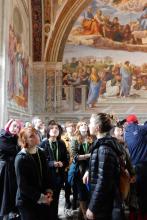Academically rewarding and intellectually transformative, the Art History Seminar in Rome provides students with an unparalleled opportunity to study art and architecture on site in one of the epicenters of Western civilization.
With its superb and astonishingly rich artistic treasures, Rome is an ideal place to investigate Italian art and architecture from ancient times to the present. Nearly all classes will take place on site, in churches, museums, archaeological sites, and public spaces in and around Rome.
While the focus of the seminar is upon th city of Rome, study trips to other locales are also envisioned. These include day trips to Tivoli, Assisi, Siena, and a week-long excursion to Ravenna and Venice.
The seminar’s goals are fourfold:
- to give well-prepared students the opportunity to experience and engage directly with original works of art and architecture on site
- to study the artist and cultural heritage of Rome and the Italian peninsula from antiquity to the modern era
- to facilitate small-group, collaborative, and in-depth learning
- to create a stimulating intellectual environment for students to grow as scholars through taking an active role in preparing, planning, and leading on-site discussions.
Students will leave the Art History seminar in Rome with both significant new expertise in art history and a profound sense of personal accomplishment.
Location
The seminar is based at the University of Washington Rome Center, housed in the beautiful and historic Palazzo Pio in the heart of Rome. Built on the foundations of the Theater of Pompey, ancient Rome’s first permanent theater dedicated in 55 B.C.E., the seventeenth-century palace incorporates a medieval tower and adjoins the Campo de’ Fiori, site of Rome’s most attractive open-air market. The Center offers full access to the UW’s online resources, a specialized library, and classroom facilities.
Program Dates
2017 dates to be determined.
Sites
The two courses make maximum use of original works of art and architecture by focusing on representative sites and monuments in and around Rome. Occasional classroom meetings supplement group visits to sites within the city, day excursions to the surroundings of Rome, and overnight field trips. Students will prepare on-site exercises and present three major individual presentations of key sites to the group. Presentation/research topics will be assigned in consultation with the instructor before leaving for Italy. The program will be supported by the resources of the UW Rome Center, which will provide classroom space, library and research access, logistic and scheduling support, and arrange housing.
Housing
Students will be staying in apartments rented through the University of Washington Rome Center. The apartments will accommodate between three and nine students and will be located within a 20-minute walk to the center.
Academics
Pre-Requisites/Language Requirements
The Art History Seminar in Rome is primarily designed for undergraduate students with a major or minor in art history. The seminar, however, welcomes students with a background in related disciplines such as history, studio art, religion, literature and anthropology. Given the academic rigors and requirements of this program, an ideal applicant would be a strongly motivated, inquisitive, and industrious student who is eager to engage in collaborative work and to learn from his or her peers. The willingness to embrace and explore a foreign culture such as Italian is highly desirable.
The selection of participants will be based primarily on academic criteria. Applicants must have successfully completed at least one course in art history or related disciplines such as history, studio art, religion, anthropology, archaeology, classics, or Italian studies at the 300-level by the beginning of the program. No knowledge of Italian is required for this program.
Credits
15 Credits
Courses
Art and Visual Culture in Rome from Augustus to Mussolini – ART H 397 (10 credits) This course provides a wide-ranging introduction to the exceptionally rich artistic heritage of the city of Rome focusing upon key artworks, monuments, and sites. As the capital of emperors, popes, and modern dictators, a goal of pilgrims, artists, and antiquarians, a repository of fabulous riches, and an object of dream and desire, the Eternal City presents us with a unique and multifaceted history. From the ruins of ancient temples to the vertiginous opulence of Baroque church interiors, from palaces and museums to fountains and piazzas, Rome provides an ideal chance to study not only some of the iconic masterpieces of Western civilization, but also the complex interaction between art, society, politics, and religion. Combining a broad chronological survey with a detailed examination of paradigmatic works, this course explores Roman art across the city’s centuries-long history as a dynamic continuum of forms, motifs, and ideas.
Art, Power and the Sacred in Medieval Rome – ART H 497 (5 credits) Spanning a thousand years from the reign of Constantine the Great to the transfer of the papal court to Avignon at the beginning of the fourteenth century, this course investigates the art of medieval Rome and the religious, political, and aesthetic concerns that shaped it. During the medieval era, the former imperial capital assumed a new identity as the most important center of Christianity in Western Europe, the seat of papacy, and a major pilgrimage site, home to countless relics of martyrs and saints. The course explores how the visual arts were mobilized to promote the power and authority of the popes and articulate Rome’s sacred identity. Topics to be addressed include the development of monumental church decoration, pilgrimage and the cult of relics, the role of icons in civic life, the phenomenon of spolia, and the nexus between art and politics. Special consideration will be given to the ways in which the art of medieval Rome self-consciously revived and reinterpreted the city’s imperial past.
2016 Program Expenses
Estimated Cost
2016 Estimated Program Fee of $7,800, UW Study Abroad Fee ($300), airfare, food (about $30/day), UW Study Abroad Insurance ($62/month), other health expenses/immunizations and personal spending money.
Average Airplane Ticket Price
$1,500 – $2,000* roundtrip
*Subject to when & where you buy your ticket
Financial Aid and Scholarships
Most forms of financial aid can be applied to study abroad. You can verify that your financial aid award will apply to your program costs by contacting the Financial Aid Office. Financial aid or scholarships awarded as tuition waivers or tuition exemptions might not apply so you will need to verify that these funds are eligible for use with study abroad by contacting the funding office.
Financial aid and most scholarships are disbursed according to the UW academic calendar (at the beginning of the quarter). If your program starts before the start of the UW quarter, your financial aid will not be available to you prior to your departure. If your program starts after the first day of the quarter, your financial aid will be disbursed at the start of the program. In either of these cases, you will have to finance any upfront costs such as airfare, health insurance and the start of your time abroad on your own. Please take this into consideration when you are making plans.
Revision Request
In some instances you may qualify for an increase in your financial aid award (typically in loan funds). Check with the Financial Aid Office about your options. To request a revision in your aid, you will need to submit the following paperwork to the Financial Aid Office:
- Revision Request Form
- Budget of student expenses for your program: the UW Study Abroad Office will upload this budget to your study abroad account after a signed contract has been submitted to the UW Study Abroad Office. You can request an unofficial copy of this budget by emailing ipe@uw.edu
Please visit the Finances section of the Study Abroad website to learn more about disbursement, revising your aid package, short-term loans and scholarships.
Application Process
The application includes a personal statement, three short answer questions, one recommendation from a professor or TA, and electronic signature documents related to UW policies and expectations for study abroad. Following the on-line application process students may be contacted by the Program Director for an in-person interview. Once an admission decision has been made regarding your application, you will be notified by the study abroad system via email.
Program Leaders
Ivan Drpic, Faculty, Art History drpic@uw.edu
Erin Giffin, Teaching Assistant, Art History egiffin@uw.edu

